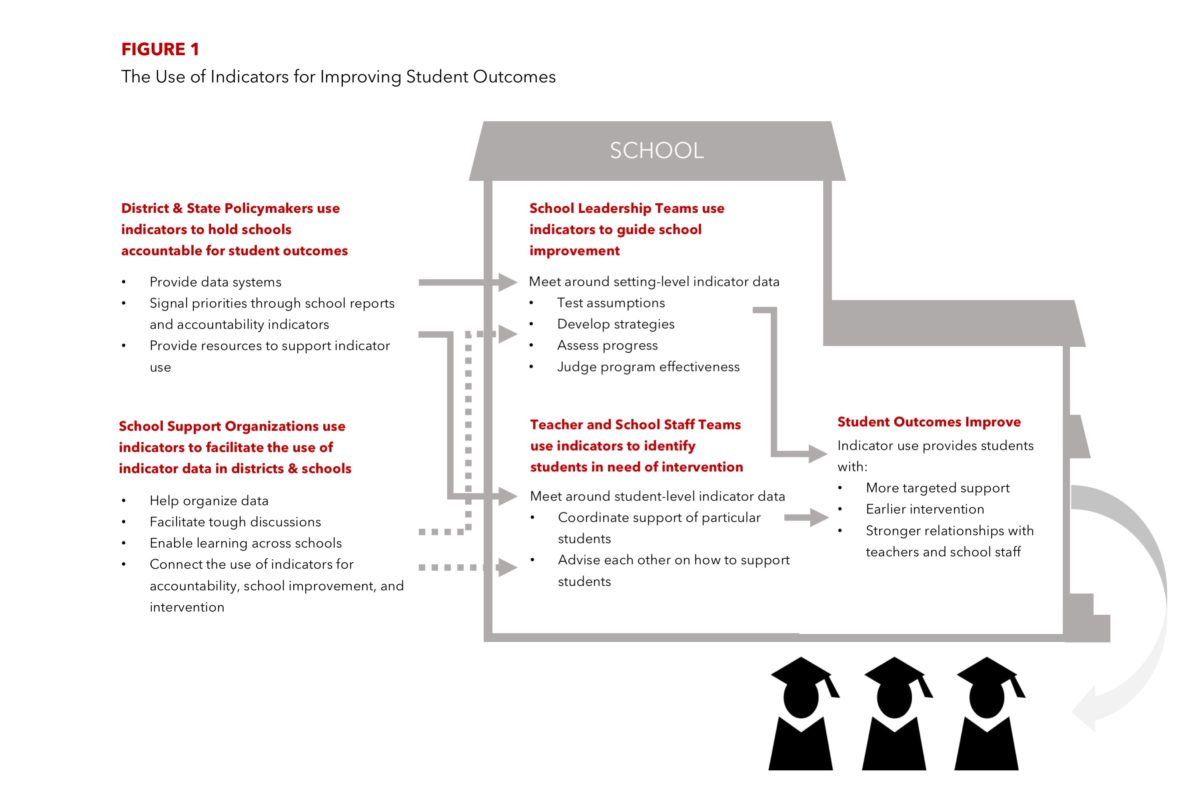The People Behind Early Warning Indicators
As we’ve been emphasizing in our previous posts, data alone is never enough. Data is just a tool that educators can use to identify and remove possible barriers to student success. And because many inequities are built into our educational system, we need people at all organizational levels who know how to collect, analyze, and proactively act on data on behalf of students.
According to High School Graduation and College Readiness Indicator Systems: What We Know, What We Need to Know, it’s “the efforts and actions of individuals in different roles that make indicators effective … policymakers, school leaders, teachers, school staff, and outside partners all play important roles…”
The figure below (from the report) shows how these different stakeholders can work together to optimize the effectiveness of an early warning system (EWS).

Effective early warning systems require teams of people who understand how to work with data for the benefit of all students.
District Leadership Teams
At the top, district and state policymakers must continue their commitment to being data driven. They must select a quality data system, establish priorities, provide adequate resources, and build a high-quality leadership team. The ideal leadership team should include educators, community and business leaders, and representatives from schools. This team should spearhead a range of initiatives—from reviewing your district’s current intervention program and recruiting talent for incorporating an EWS, to establishing ownership among key stakeholders.
School Leadership Teams
At the site level, school-based teams should be tasked with running and optimizing the EWS for their own location: testing assumptions, developing strategies, assessing progress, and making any necessary adjustments. Team members should work with setting-level data to guide school improvement and use student-level data to identify and provide support to at-risk students. One of the most important responsibilities of school leadership teams is to train teachers to collect data and turn it into action on the students’ behalf. Instructional technology experts are often the best qualified to conduct this training.
Teacher and School Staff Teams
Teacher and school staff teams should focus on student- level indicators, using data to identify at-risk students and provide them with appropriate supports to be successful. In an ideal scenario, educators who work with the same students should team up to coordinate academic, behavioral, and social-emotional supports.
The University of Chicago report highlights the importance of school-to-home communication, providing this example:
…a school might regularly send out information about its prog¬ress in meeting overall attendance goals, along with a summary of research findings on the relationship between attendance and learning gains or educational attainment. This can help families make the connection between their own child’s attendance, their goals for their child’s educational attainment, and the broader goals of the school.
Teachers are often the best link to parents. By helping parents understand the links between data and student outcomes, they can play a critical role in EWS.
Support Organizations and Consultants
Many districts can benefit from external support services and consultants who have experience in data collection and analytics. Because every EWS is complex and requires considerable amounts of time and knowledge, outside organizations can often provide the expertise, support, and training districts need to ensure sustainability.
Community Partnerships
Whether or not a school uses outside consultants or support services, school leadership teams should search for community-based organizations that might be able to help students with tutoring, internships, or health services. Community partners can provide a valuable boost to school EWS programs.
Data is necessary to drive positive change for all students, but it’s people who really make the difference. As you consider implementing an EWS for your district, make sure your staff is prepared to work with data to help students succeed.
*****
Illuminate Education is a provider of educational technology and services offering innovative data, assessment and student information solutions. Serving K-12 schools, our cloud-based software and services currently assist more than 1,600 school districts in promoting student achievement and success.
Ready to discover your one-stop shop for your district’s educational needs? Let’s talk.


This mark another milestone in my journey in the edu sector as I have lots of educational platforms that have inspired me a lot and this wouldn’t be an exception.
I enjoyed this article very much. It takes a village to raise a child.
It is extremely important for everyone to participate to ensure success of a student.
Data has become such a focus in schools, but it only goes so far. The classroom teacher is often the one to connect the dots of why a student may not be succeeding in school.
It takes teamwork to help a child succeed. Data by itself does not help much. We must put it into action.